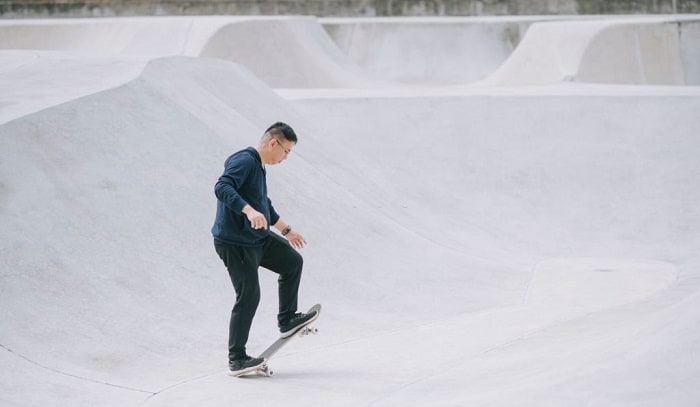For someone who just started to skateboard, it’s not easy to drive the board’s direction. You will need to manage your body weight, stance, riding environment, and many more factors to control the trajectory of the skateboard. Nonetheless, turning on a board is never far from possible.
With these in mind, let me share how to turn on a skateboard. That way, you won’t have a hard time riding it anywhere. Plus, it can also help protect you from possible accidents. Below is the focus of our tutorial.
- Proper stance
- Weight shifting
- Managing turns
Table of Contents
What You Will Need
More often than not, a first-time skateboarder would choose to learn skateboarding by turning anywhere open. To be sure you’re safe and improving, take note of things we need to prepare.
An open skating area
Of course, you won’t be able to direct the board on your first few tries, especially if you haven’t mastered the tendencies of its components yet. Don’t worry because all skateboarders have been there. And so, to address this, we need to have a wide-open skating site.
This requirement is not too hard to meet because it comes in many forms. It could be a free parking garage, a spacious and unbusy street, or even a skatepark with enough flat ground surfaces.
The reason why we need a large skating area is to protect you from injuries and accidents. These casualties often come from bumping into fixtures or objects around you. So, we need to avoid them until you master turning on your board.
Comfortable clothing
Unlike flip tricks or any complicated skill that requires a set of protective gear, skateboard turning only calls for you to be comfortable with what you wear. You will start practicing in huge spaces until you perfect this skill. So, joint supports like knee pads and wrist guards may not be necessary.
The only thing you have to wear when practicing skateboard steering is something that will let you move freely. It could be a loose shirt and pants. Also, don’t forget to wear socks and shoes that are most comfortable for you. The goal with these pieces of clothing is to let you move your arms, knees, shoulders, and any body part without difficulty.
Your skateboard
While you can use almost any skateboard to turn in your desired direction, it would still be best to use the most appropriate one. That way, learning the skill won’t seem too hard for you.
The characteristics of an ideal skateboard on this occasion include a set of wheels with perfect rolling speed and good grip. Also, a mid-sized skateboard would be a good choice because it has a balanced weight, making it more maneuverable.
Let’s focus more on the trucks, where most movements happen. For purposes of durability, we’ll need a pair of aluminum alloy trucks. Plus, a good set of these components has to be responsive and flowy. That way, you won’t have a hard time controlling the entire board system.
A pro tip: You might as well keep a skate tool with you. Sometimes, you may need loose trucks or tight trucks for better execution.
Steps to Turning
You cannot solely rely on your weight estimation and mere observation of other experienced skaters when turning on a skateboard. Follow the steps below, and we’ll make sure you’ll know how to steer a skateboard perfectly.
In this tutorial, we’ll classify the skill into two parts: the lean and the lift. The lift is also known as the kick turn.
Turning by leaning
Step 1: Feet positioning
Stand facing the length of your skateboard. Place your back foot right on top of the back wheels of the board. Follow with your front foot over the front truck.
Take note that your feet should be perpendicular to the board’s length, with the toes of your front foot slightly angled to the nose. Also, ensure that the core of your feet is in the middle of the board for better stability.
Step 2: Obtaining momentum
Turning on a skateboard by leaning is similar to carving. Both of these skills require some momentum to help you appreciate the changes in direction.
So, after securing the proper footing, get off your board and start pushing it in a straight line. Be sure to head on a free space to avoid bumping. Once the board gains some speed, put your feet on the skateboard deck like in the previous step.
Step 3: Leaning
This step has two kinds: leaning forward and backward. And for purposes of illustration, suppose your left foot is in front.
If you want to turn to the right, all you need is to lean forward. Plus, be sure your toes press on the edge of the deck. Turning to the left will require you to lean the opposite way, putting pressure on your heels. Also, applying more pressure on your heels or toes will make you turn sharper.
Both of the forward and backward techniques will need the help of your shoulders, knees, and arms. So, when you lean, try to guide the board’s direction using your shoulders. Also, keep a balanced and normal stance by bending your knees and spreading your arms.
The kick turn
After you master the lean method, we’ll proceed with the kick turn. Take note of the following steps.
Step 1: Footing
Leaning on a skateboard to turn and lifting it are somewhat identical in terms of foot positioning.
With your left foot as the front foot still, keep it in the same position as you did with leaning. What makes the difference is your right foot. You will have to place it on the tail of the deck. Make sure it’s right in the middle of the deck tail to help you get more control of it.
Step 2: Stationary lift
All you need to remember for this step is the lift-and-drop routine. With your back foot, apply pressure on the tail of the skateboard. It could be a bit challenging, but try to keep the rear end of the board from touching the ground. You don’t want to stop somewhere by scratching the board’s tail on the road.
So, to master this step, do it slowly while keeping your weight centered. Don’t worry if you tend to drop the nose of the board or press on the tail forcefully, as this skill requires constant practice and estimation.
Step 3: Stationary redirection
The next thing we do with the skateboard is to rotate it. Still in a stationary position, press on the tail of the deck with your back foot. But before you drop it this time, try to redirect the nose of the board first.
You can do it by winding your hips and shoulders and guiding the front of the deck using your front foot forward. It’s like transferring your force from your shoulders down to your legs. You can rotate the board in a forward direction, or you can do it the other way.
A pro tip: It’s best to turn frontside first since it’s easier to perform. Later, you’ll learn the backside left turn after completing its counterpart.
Step 4: Changing directions in transit
This step is the culmination of all the turning practice you had. Put your skateboard in the parking lot or somewhere with enough space around it. Start riding it until you obtain some momentum.
While the skateboard is rolling, put your feet into the turning position. With a decent speed, perform the redirection process smoothly but a bit quickly.
In all these stages, always try to keep your balance by shifting your weight to your center. Also, support your movements using your upper body. These will help you avoid falling backward when the board is in motion.
Pro Tips
- Tighter trucks or looser trucks will help you perform the trick better. Consider assessing what tightness level will make your skateboard turn better.
- Start your rotations in small angles until you manage to turn on wider angles.
- Some skaters tend to neglect this aspect, but practicing at slow speeds first will ensure your safety.
Conclusion
Turning on a skateboard helps you enjoy your rides more, especially while cruising. You get to change directions with ease, and you also master balancing on the board. All these are indications that you’re learning new skills and becoming a better skateboarder.
So, now that you know how to turn on a skateboard, you won’t need a dead stop to change direction. The truth is, you now have better control of the board.
Riding the skateboard anywhere you want is a different kind of feeling. Did you enjoy this tutorial? Leave your inquiries in the comments section.

Hi, I am Charles Harris. I opened this site to write as much as I can about my biggest passion – skateboarding!
I started as a clumsy yet passionate rookie 10 years ago to now a still passionate yet much better skateboarder! But I have to tell you, the whole journey has always been fun and rewarding, indeed not without hardship.





